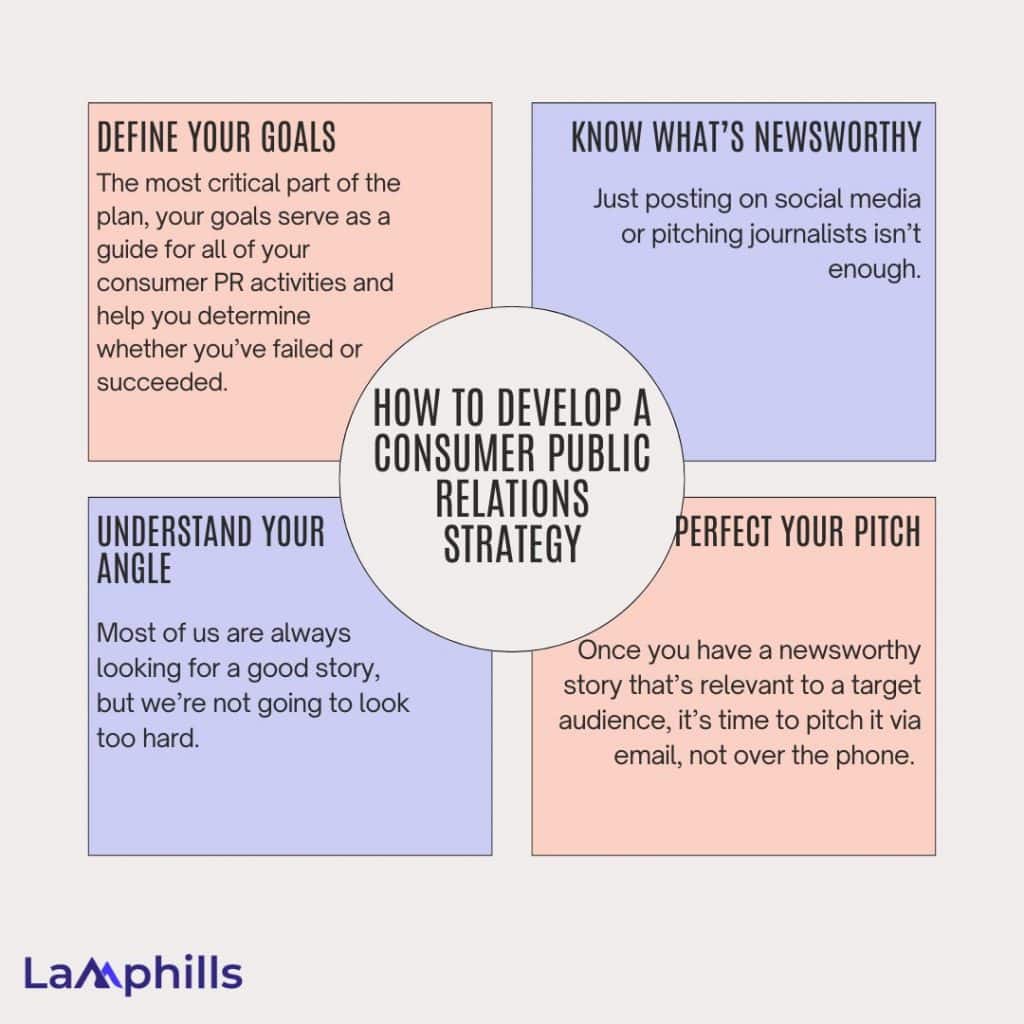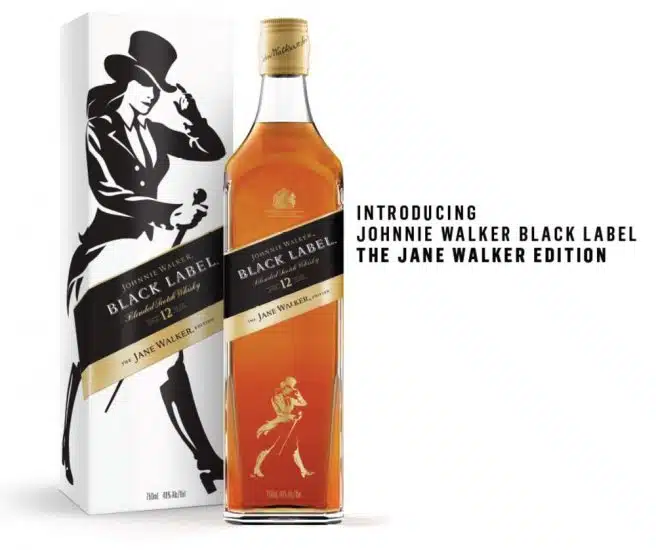If you’re looking to create some noise around your brand and products, consumer public relations is a powerful tool not to be overlooked. It’s a great way to tell your brand’s story, create stand-out and get you noticed by your target audience, all of which can give you the edge over your competitors.
Regarding consumer public relations, it’s not a one-size-fits-all approach, nor is it only for major brands and large companies. The right PR strategies can seamlessly work alongside your other marketing activity to strengthen your message and audience reach and help build genuine relationships with consumers.
Still unsure how consumer public relations work for your business? Keep reading to learn everything you need to know, including definitions, meanings, and importance of consumer public relations.
Key Points
- Consumer Public Relations (C.P.R.) is a strategic communication process focusing on building and maintaining a positive relationship between a company and its consumer audience.
- There are several ways in which consumer public relations can activate more engagement, including a unified focus on omnichannel marketing, interesting stories being key, and authentic interactions being critical.
- The importance of consumer public relations includes increasing brand awareness, building a strong brand image, promoting credibility, helping manage reputation, and strengthening your online presence.
- To develop a consumer public relations strategy, you must follow the following steps: define your goals, know what’s newsworthy, understand your angle, and perfect your pitch.
- Examples of consumer relations include Spotify wrapped, Lego, Old Spice, and Johnnie Walker
What Is Consumer Public Relations?
Consumer Public Relations (CPR) is a strategic communication process focusing on building and maintaining a positive relationship between a company and its consumer audience. From purpose-driven PR to product launches and experiential PR, consumer public relations gives consumers an additional positive touchpoint that builds trust, anticipation, and loyalty from consumers. Consumer public relations is an effective lever for ambitious brands, particularly during hyper-growth or product launch phases.
This is in contrast to B2B PR, which seeks to improve the reputation and awareness of a company within a particular business vertical. Brands know new customers buy faster, and existing customers buy more often from brands they feel good about. Consumer public relations can take on many sub-forms of public relations, including:
- Community Relations: building relationships with community stakeholders.
- Product Public Relations: Product reviews and placements in consumer publications.
- Purpose-driven PR: Proactive values incorporating social, cultural, and environmental issues.
- Experiential PR: Opportunities for the public to engage directly with the brand in person.
- Integrated PR: PR campaigns that use paid avenues to create media coverage and word of mouth.
Evolution of Consumer Public Relations
Consumer public relations has witnessed a significant evolution over the years, adapting to the ever-changing dynamics of consumer behavior and technology. In the past, traditional media outlets, such as newspapers, magazines, and television, played a dominant role in shaping consumer opinions. Brands relied heavily on press releases, media relations, and advertising to communicate their messages to the masses.
However, with the advent of the internet and social media, the consumer PR landscape has undergone a profound transformation. Consumers can now access information at their fingertips and voice their opinions, experiences, and grievances online. This shift has compelled brands to adopt a more proactive and strategic approach to consumer PR, focusing on two-way communication, engagement, and transparency.
How Modern Consumer PR Changed Its Focus
Since social media allows companies to directly engage with their target audience, consumer public relations has become a way to connect with all audiences in real-time, not just through planned, traditional media.
Specifically, there are several ways in which consumer public relations can activate more engagement:
- There’s a unified focus on omnichannel marketing: Since people are often active on multiple social media platforms, companies now have an expectation and opportunity to connect with their audiences where they are. From engaging with media via Twitter DM to identifying and working with influencers through social platforms, consumer public relations has become a more integrated part of the overall marketing machine.
- Interesting stories are key: Modern consumers are extremely sensitive to companies pushing their products to them; the hard sell doesn’t work. No one wants to hear a company talk about how great they are; they want you to prove it to them consistently. Demonstrating value and leading with a compelling story — whether through customer testimonials, unique insights, or day-to-day access — can make consumers feel more invested in your brand.
- Authentic interactions are critical: Consumers crave authenticity in all marketing and PR. Jaded by decades of dishonest marketers and scams, consumers now only work with companies they trust, and to build that trust, communication has to be swift, transparent, genuine, and thoughtful. An official public statement or announcement can now be communicated in minutes via social platforms, and often, this is the number one place consumers go first.
Importance of Consumer Public Relations

Let’s look at the benefits of consumer public relations.
#1. Increases Brand Awareness
The core function of consumer public relations tactics is to inform people about a brand, ultimately widening its consumer base. It involves sharing innovative and thought-provoking brand messages over multiple channels to garner more attention. Your consumer PR agency should be able to articulate expected PR KPIs.
#2. Builds a Strong Brand Image
Consumer public relations not only focuses on creating brand awareness but also helps you reinforce a positive image in the market. With a strong brand image, you can enjoy higher engagements, increased sales, and significant growth in market share.
#3. Promotes Credibility
Consumers trust a brand better if they know how it operates. This is where consumer PR can help. Consumer public relations professionals strive to create positive talk about a brand amongst the public in different ways: publishing leadership pieces, building influencer connections, and implementing networking strategies. Your credibility soars high once the positive messages about your brand become common to the public.
Building trust with your customers couldn’t be more important if your product helps consumers with a health issue, or with small children, or helps them navigate a particularly challenging phase of life.
#4. Helps Manage Reputation
Reputation refers to how people perceive your brand based on what they see and hear. It can be positive or negative and change. Reputation management is one of the main functions of consumer PR strategies for consumer PR professionals.
Businesses may often find themselves in unfavorable situations, like negative reviews from a dissatisfied customer or legal problems arising from a misinterpreted advertisement. Consumer public relations helps them avoid such problems and repair the damage through media connections and press releases.
#5. Strengthens Your Online Presence
A robust online presence is key to success in today’s era. As a part of consumer PR strategy, a brand can use social media and other digital platforms to talk to its customers, resolve conflicts, and monitor their changing interests.
Consumer PR experts can build a plan to stay active on online platforms to grow relations with all groups of consumers.
What Is Consumer PR vs Corporate PR?
The power of PR is unparalleled, helping individuals and businesses to control their public perception and reap the rewards of a more positive reputation. According to the Public Relations and Communications Association (P.R.C.A.), the most recent statistics show that the U.K. PR industry was worth £14.9 billion in 2019, and it’s only expected to have grown in size since.
The two main types of PR are consumer and corporate PR, but the difference between them isn’t apparent to many. To clarify the confusion and ensure you know what type you require for your brand, I’ve broken down consumer PR vs corporate PR below. The main differences between consumer and corporate PR are:
#1. Target Audience
While consumer and corporate PR activities aim to promote a business’s credentials to generate more income, the targeted audiences differ.
Consumer PR can be considered a B2C strategy that aims to improve public perception and convince consumers to become customers. On the other hand, corporate PR is a more B2B approach that is laser-focused on attracting income from other businesses or investors.
That said, sometimes people refer to corporate PR as any kind of promoting a business (regardless of who it’s appealing to), meaning the lines between the two can be blurred.
#2. Outreach Channels
PR strategies need to be adapted to their target audience, so it stands to reason that consumer and corporate PR strategies tend to use different outreach channels. For instance, an omnichannel social media strategy across TikTok, Instagram, and Twitter will likely appeal more to consumers than a professional post on LinkedIn. Similarly, a feature in a lifestyle magazine will generally have more value for consumer P.R., just as a feature in a trade publication would for corporate P.R.
#3. Strategy
Corporate PR is all about knowing and understanding market trends, identifying business owners’ pain points, and positioning a brand’s service or product as the solution to those problems. Consumer PR is more about understanding what’s hot in the world of the consumer, like viral news stories or lifestyle trends, and aligning a brand’s product or service with that conversation to make it appeal to potential customers.
What Are the Key Players in the Consumer Public Relations Industry?
The consumer PR industry comprises various key players who contribute to shaping and implementing effective brand PR strategies. These players include:
- Public Relations Agencies: PR agencies specialize in providing strategic counsel, media relations, crisis management, and event planning services to brands across different industries. They possess the expertise, networks, and resources to create impactful PR campaigns that resonate with consumers.
- In-house PR Teams: Many large corporations and organizations have dedicated in-house PR teams responsible for managing all aspects of consumer PR. These teams work closely with other departments, such as marketing, communications, and customer service, to ensure a cohesive and consistent brand image.
- Digital Marketing Agencies: As the digital landscape expands, digital marketing agencies have become valuable partners in consumer PR. They leverage digital channels, such as social media, content marketing, and influencer collaborations, to amplify brand messages and engage with consumers effectively.
- Market Research Firms: Market research firms play a vital role in consumer PR by providing valuable insights into consumer behavior, preferences, and trends. These insights help PR professionals tailor their strategies to meet consumer expectations and demands.
- Social Media Managers: With the rise of social media platforms, social media managers play a critical role in consumer PR. They create and curate content, engage with consumers, monitor brand mentions, and manage online reputation.
By collaborating and leveraging the expertise of these key players, brands can develop comprehensive consumer PR strategies that resonate with their target audience and drive positive brand experiences.
How To Develop a Consumer Public Relations Strategy

Since modern marketing and PR are focused on empowering customers to make informed purchases, marketers need to develop a strategy that is focused not just on their brand but also on their customers. So, how do you develop a winning plan for increasing your business publicity? Here are four steps to developing a winning consumer PR plan.
#1. Define Your Goals
The most critical part of the plan is that your goals guide all your consumer PR activities and help you determine whether you’ve failed or succeeded. Some common examples of PR goals include:
- Maintaining a positive reputation
- Increasing customer loyalty
- Increasing brand awareness
- Supporting marketing campaigns
- Building investor confidence
- Managing brand perception during crises
#2. Know What’s Newsworthy
Just posting on social media or pitching journalists isn’t enough. Having a consumer PR plan in place is pointless if you pitch bloggers or media outlets with evergreen, vague, and non-newsworthy stories. Here are some common opportunities to generate timely publicity for your business:
- Corporate news
- Company launch
- Product launch
- Data or research
- Response to a news event
- Partnership
- Funding or investment
- An upcoming event
- Customer insight
- Seasonal tie ins
#3. Understand Your Angle
Most of us always look for a good story, but we won’t look too hard. With distractions and notifications increasing daily, you must ensure that stories are relevant to audiences if you want them to resonate and drive action. In journalism, this is called the “angle” of your story. Your angle is the reason why your story is interesting. Always tie back to the big why — why should they care, why now, why is your company or customer the best at what you’re doing? Tell people how your story affects them.
#4. Perfect Your Pitch
Once you have a newsworthy story relevant to a target audience, it’s time to pitch it via email, not over the phone. Often, journalists and editors won’t have the time to listen to someone’s story, making email a better arena to give your pitch. A pitch is when you describe a potential story and its relevance to a journalist or editor. When you’re pitching your story, it’s important to be concise. The best pitches consist of a simple introduction of you and your story and a few reasons why it is relevant to their readers.
In addition, make sure to only pitch publications that are interested in your type of story. For example, if you’re announcing a product launch, you shouldn’t pitch journalists who cover political events. Tools like JustReachOut and MuckRack can help you easily find relevant journalists, and sites like HARO can even tell you which reporters are looking for sources for stories right now.
Another important aspect of pitching a journalist is having an electronic press kit. Press kits contain materials that help journalists learn more about you, your company, and its background. Good press kits also include high-quality professional headshots for journalists to include with your story and a fact sheet or list of frequent questions. The more information you provide to journalists, the easier it will be for them to write your story.
Several Consumer PR Strategies for Consideration
Although there are a lot of stories to tell, here are some examples of successful strategies that may resonate with your business.
#1. Support a Cause
As a business, one of the most effective ways to generate publicity is to support a worthy cause through donations or partnerships. According to the Edelman TRUST BAROMETER, 80% of customers believe businesses should play a part in addressing social issues.
For example, the Kentucky-based bourbon company Maker’s Mark partnered with One Warm Coat to drive awareness and support for giving warm coats to those in need. As a result, Maker’s Mark gained more than 40,000 new followers across their Instagram, Facebook, and Twitter channels.
#2. Make It Personal
Good or bad, the experiences customers have with employees or on social media will affect their perception of a brand. One way to gain an edge is to personalize emails, products, and services to specific audiences.
A popular example of personalization is Coca-Cola’s “Share A Coke” campaign, originally started in 2014. By inviting people to share or customize their soda with their friends based on either the name, endearment, or nickname, Coca-Cola increased sales to record levels.
#3. Lead Your Industry
Establishing trust is a critical component of all modern campaigns. Customers want to work with companies involved and respected in their industry. Because of this demand for trusted expertise, business leaders invest in strategies promoting themselves as “thought leaders.”
Becoming a thought leader means providing informative comments and opinions on trends and events within an industry. Teaching courses, giving presentations, and writing blog posts are popular ways by which people establish themselves as trusted experts within their industry.
#4. Build Your Community
Similar to thought leadership, companies also get involved with their local communities. By donating time, facilities, products, or money to improve your community, a brand can demonstrate goodwill and trustworthiness, making customers more likely to buy from them and recommend them to those in their personal or professional networks.
Here are some ideas on how you can get involved in your community:
- Serve on a community board or chamber of commerce.
- Volunteer at a local homeless shelter.
- Donate your products or money to support a local charity.
- Participate in local festivals or parades.
How Do You Build Consumer Relations?
Building strong consumer relations is essential for any business aiming to achieve long-term success. Below is a comprehensive checklist guide that I have provided to help you navigate the process:
How to Build a Consumer Relations Checklist
What Are the Examples of Consumer Relations?
Journalists crave juicy stories and viral marketing campaigns, but standing out in a sea of conventional pitches is one of the biggest challenges for any public relations professional.
When you need a dose of inspiration, it can be helpful to explore the most compelling PR plays in recent years. To save you some time, I’ve curated a list of the absolute best of the best to get the creativity flowing for your next campaign. Here are some of the top examples of consumer relations.
#1. Spotify Wrapped

Spotify’s Wrapped campaign has quickly turned into a viral, end-of-year event. Since 2016, the streaming app has provided users with a “wrap-up” of their listening habits delivered in colorful, eye-catching graphics. You can share your stats on different platforms, like Instagram and TikTok.
Spotify’s Wrapped is not just another marketing campaign— it’s a viral, multi-platform, FOMO-inducing social campaign. It’s highly personal, relevant, and shareable. It’s this winning combination that its rivals, namely Apple and YouTube, haven’t been able to recreate.
#2. Lego: Rebuild the World
According to Lego, rebuilding the world starts with a single (lego) brick. It’s a powerful message for those rebuilding their lives following several tumultuous years — and one delivered by a company that believes in building, experimenting, and breaking the rules.
This campaign is not only well-timed, but it effectively presents its products in such a way that goes beyond their basic functionality.
#3. Old Spice: Paper Blazer Ad

When Fragrance brands advertise in magazines, they usually show off their aromas by drenching an ad with their latest cologne or perfume. But Old Spice realized people usually don’t enjoy unexpectedly pungent scents violating their nostrils when they’re flipping through their favorite magazine.
So, in typical Old Spice fashion, they gently ribbed other fragrance brands by inserting a paper blazer doused in their new cologne, Captain, in their print ad in GQ magazine. Then, they wrote about how these paper blazers can help men attract attention with trendy style and masculine smell. The only drawback of the blazer is that it’ll turn into papier-mâché on you in the rain.
Humor and cleverness are some of the best ways to appeal to your audience and gain earned media attention, and it seems like Old Spice can leverage them both on any marketing channel.
#4. Johnnie Walker: Jane Walker

To promote gender equality and honor the many achievements of women throughout history, Johnnie Walker launched a female version of its whisky called Jane Walker on International Women’s Day. The limited-edition bottle featured a woman on their iconic logo instead of a man, connecting the brand to individuals who supported their commitment to social progress.
In March 2018, Johnnie Walker released 250,000 bottles of Jane Walker, and for every bottle sold, they donated $1 to organizations that empower women. This tangible impact helped their campaign gain even more support and publicity.
Is Customer Relations the Same as PR?
Indirectly, yes_ public relations (PR) and customer relations share the goal of managing relationships but differ in scope. PR focuses on shaping public perception through media, events, and communication strategies to build brand reputation and maintain a positive image. On the other hand, customer relations centers on interactions with individual customers to enhance satisfaction, loyalty, and retention. While both aim to cultivate positive relationships, PR targets broader audiences, while customer relations is more personalized and aimed at improving individual experiences.
Methods and Performance Indicators of Consumer PR Campaign
Consumer PR experts can use different methods to get their message out to the public, such as:
- Videos
- Events
- Content
- Collaborations with Influencers
- Seasonal News
Here are a few common factors that show the performance of your consumer PR campaigns:
- Likes, Comments, and Shares on Social Media
- Views and Shares of Content
- Referrals to Website from Content
- The Number of Leads and Conversions on the Website
- Mentions on Social Media
Bottom Line
Mastering the art of consumer PR is vital to survival in today’s competitive market, especially for small businesses, and can help maximize all the amazing things you’re doing internally if done right. Don’t take a spray-and-pray approach; consider your narrative, mediums, and tactics. Personalization is key, as is knowing your audience and what matters to them. By developing a solid consumer PR plan and using proven strategies, you can increase awareness for your business and build a great brand.
Similar Articles
- The Role of Public Relations in Tourism and Travel: Practical Tips and Personal Stories
- Media Relations: Everything You Should Know (Updated)
- PUBLIC RELATIONS SERVICES: The PR Blueprint for Getting Your Brand Noticed
- Key Roles of Public Relations In Marketing






